A sports moped of the 1970s is appreciably different from a typical 50cc scooter of the 21st century…
Still a little dazed from his spill, Sam sat up and looked around. Everything looked the same – but somehow different! There seemed to be a lot of old cars parked about here: Cortina, Marina, Vauxhall Viva?

The bike was lying ahead in the hedge, but it didn’t look like his scooter. The registration number seemed similar, well, the numbers and letters did, but all the other way round. Three letters, three numbers, and then another letter?
Stumbling across to the bike, Sam picks it up and looks it over. Seems OK, but this isn’t my bike, what is it? Nothing like his Yamaha Aerox scooter, this looks like a little motor cycle, then Sam recognises his keyfob dangling from the key in the steering headset!
At this point, Sam doesn’t quite grasp that the incident has somehow slipped him back a few decades, but decides he’s going to have to ride this old style motor cycle if he wants to get home, and the bike he has now is an old Yamaha FS1-E.
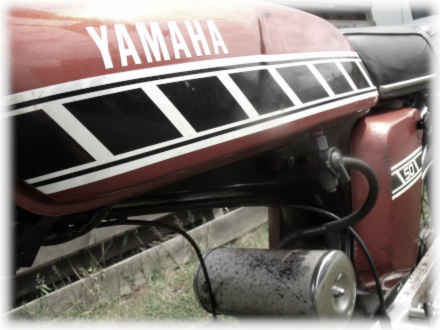
What’s that sticker on the fuel tank ‘mix 20:1 ratio’? What’s that about? It’s so old that you have to pre-mix oil into the fuel. As well as auto-lube oil injection systems, most 21st century scooters have automatic vacuum fuel taps and automatic choke systems, so manual fuel taps and choke controls are features that modern riders may be unfamiliar with. Instead of a vacuum tap there’s a manual fuel tap under the left side of the fuel tank Off–on–reserve (with a gravity filter bowl to skim off impurities). OK, so we know the FS1-E must have a choke control somewhere … not on the handlebars … not on the headset … can’t see any carb … Ahhh! There’s a knob poking up out of the right-hand crankcase cover, and pull to choke. Of course, the engine is disc valve, so the 16mm Keihin carb fits directly on the side of the engine.
Wow, it has an 80mph speedometer! The key switches off–on–lights, now where’s the starter button—beep! Ahh, that’ll be the horn … no, that’s all, so there’s a funny shaped kick-start down on the right hand side just behind the footrest—hold on, that’s a pedal, not a footrest!
What’s going on there then? The pedals on each side both sit forward like footrests!
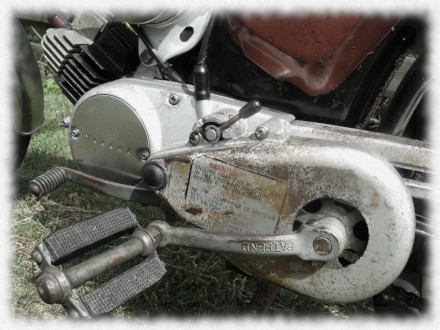
There must be some way to operate these like pedals … hmm … turn the switch on the left-hand case to pedal position as indicated on the graphic … rotate the left-hand pedal arm backwards 180°, then the right-hand pedal arm pops out on a spring and locks the pedals into offset engagement. Transformation, sports-50 into moped!
The gearbox needs to be in neutral to pedal, otherwise the engine is engaged, but pedalling efforts are sapped by internal drag within the motor, to the degree that cycling this machine is exhausting and completely impractical.
The ineffective pedal arrangement was merely to make the bike compliant with the ‘moped definition’ law of the time, but never had any useful functional purpose other than being a ridiculous way of engineering a set of footrests!
The funny kickstart only has a limited arc, and doesn’t turn the motor over very much on each stroke, but the engine fires up after a few kicks. The motor fades if you try and push down the choke too soon, so there’s a necessary period of waiting a minute for the motor to warm a little. Right, off we go, open the throttle …. revs, but nothing happens, no drive! Ahhh, of course, not twist and go, it has manual gears and clutch.
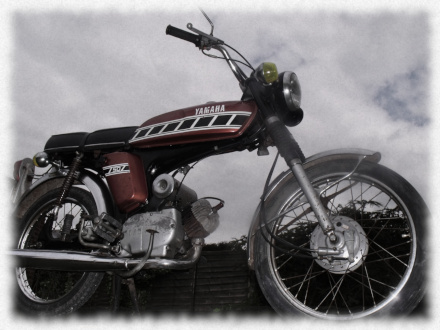
The gear lever is a rocking-pedal, heel-&-toe to the left foot. Pull in the clutch lever, nice and light, then with neutral positioned at the top of the four-down gearbox, click forward and down for first, throttle on and feed out the clutch. Take-off is smooth and brisk, then down again into second, and down again all the way to top fourth. The power delivery is noticeably constant right through the rev range and up through the gears, so no peaky ‘power band’ surge as the revs run up.
There are indicators, but the beam–dip is on the left! The indicator switch is on the right bar set! Yes, everything is backward compared to a modern scooter—this is really mad…
Comfortable cruising was effectively up to 35mph, though the bike would readily run faster than that, it just felt to be pushing a bit harder above that figure.
On the flat in a crouch with crosswind clocked 42, with a tailwind 44, and 46mph on the downhill run. The following uphill section was confidently despatched at 36mph when cresting the rise, and the 80mph Nippon Seiki speedometer proves pretty accurate to our pace bike.
This FS1-E is completely original, unrestored, dates from 1977, and finished in Baja brown with ‘speedblock’ decals.
![]()
The next morning Sam woke up with a thumping headache. His mother said he’d run his scooter into a hedge and the doctor said he’d got concussion. Sam couldn’t remember anything much, except the old Yamaha sports moped, so he looked it up on the internet, and was surprised when he found lots of information! So this was a real bike, maybe it wasn’t a dream?
The FS1-E ‘sports moped’ was originally launched in the UK in August 1972, as the Yamaha SS50 ‘Sixteener Special’, and finished in Candy Orange.
Honda however took exception because they already had their own SS50 sports moped established on the market, so in January 1973, Yamaha changed the designation to FS1-E, and a legend was born.
Yamaha reported the motor specification as 4.8bhp @ 7,000rpm, from a 7.1:1 compression ratio, 16mm carburettor, four-speed gearbox, and quoted a 45mph performance. Lighting was 6V × 18/18W headlamp, 6V × 5/21W tail & stop light.
Frame number prefixes go some way to identifying models:
| 394 = | Pedal models, all unrestricted. FS1-E Candy Orange 1972–74, Popsicle Purple August 1974–76, Baja Brown August 1975–76 (pinstripe decals). Baja Brown 1976–77 (speedblock decals) FS1E-A Space Blue 1977, drum brake & FS1E-DXA Chappy Red 1977, disc brake (revised speedblock) |
| 596 = | Pedal models, all unrestricted. FS1-ED Competition Yellow 1975–76 (pinstripe decals), disc brake. FS1-EDX Competition Yellow 1976–77 (speedblock decals), disc brake. |
| August 1977 introduced significant changes to comply with the revised moped definition law. Around the same time, Autolube systems were introduced and, although the pedal mechanism was still fitted, the pedals were replaced with footrest arms. However, the Autolube and footrest-style pedals had already appeared on the last unrestricted 1977 Space Blue and Chappy Red models (which were only sold for a couple of months up to the end of July 1977). |
|
| 2GO = | Footrest models restricted FS1-M French Blue Metallic 1977–79 (revised speedblock) FS1-MDX Wineberry Red 1977–83 (revised speedblock) |
| 3F6 = | Footrest models restricted FS1 Caribbean Blue 1987–92 (white block decals) FS1DX Maxim Red 1978–83 (black block decals) These had the bigger square tank instead of the slimline tank used on earlier models. |
| 5A1 = | Footrest models restricted FS1E-SE (Custom) Maxim Red & Yamaha Black 1981–83. |
FS1-E’s heyday was undoubtedly throughout ‘The Sports Moped Era’, from 1973 until the effective law change of August 1977.
Official UK FS1-E sales in the years up to 1978 accounted for 67,669 machines.
UK sales over the following three years added together only amounted to a mere 5,627 machines, so starkly brings into perspective the effect the definition change had upon the ‘Sports-50’ market.
Basically, the FS1-E dream ended with the 1977 restricted specification moped law change.
The classic ‘slimline’ FS1-E was restyled in 1987 to a more conventional motor cycle form, which pretty much rubber-stamped the end of the legend.
The ‘Fizzy’ was finally and officially withdrawn in 1993, but had actually fizzled out of the UK market somewhat before that.
![]()
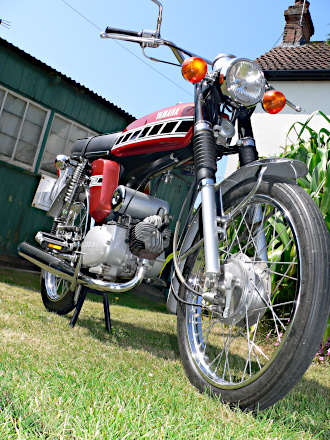
Sam sold his Aerox, passed his car test, and bought a Ford Fiesta. Fifteen years later he was married with a mortgage, and two young children, but had saved up for a nostalgia auction bid on the bike he really wanted to ride again. Many people return to the bike they first rode, but his choice wasn’t the Yamaha Aerox scooter that you might expect … Sam bought a Yamaha Baja brown FS1-E of his dreams, in fully restored to as new original condition.
Now a strapping young man of six-foot-three, and several kilos heavier than the lithe teenager that rode the same bike two decades ago, so what are the chances that it might perform the same? So we have an identical 1977 Baja brown machine, with speedblock decals, it’s just that this one looks new!
Still conditions on the day of our test noted comfortable cruising around 35mph, recorded 41mph sitting upright along the flat, 42 in a crouch on flat, 43 downhill, and the 80mph Nippon Seiki speedometer again proves pretty accurate to our pace bike.
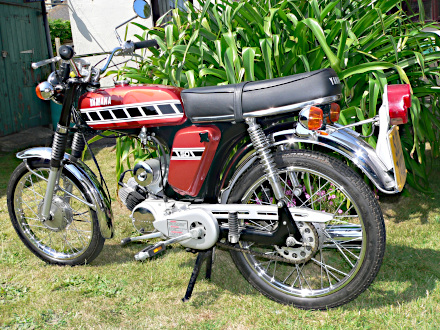
Everything worked properly, all electrics, brakes, handling, and the steering felt light and nimble.
The FS1-E was one of the most iconic sports mopeds of its era, which totally epitomised the time and the moment.
The sports moped age was eclipsed by legislation from 1977 by the moped specification change, but even 40+ years later, young motor cycle riders who weren’t even born at the time, still identify the classic FS1-E for what it is—the sports moped is long gone, but the legend lives on…
![]()


